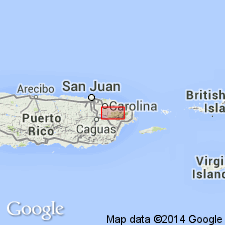
- Usage in publication:
-
- Lomas Formation*
- Modifications:
-
- Named
- Dominant lithology:
-
- Lava
- Breccia
- Sandstone
- AAPG geologic province:
-
- Caribbean region
Summary:
The Lomas Formation, here named, consists of a thick sequence of basaltic to andesitic lava and poorly sorted volcanic breccia and sandstone. Is restricted to fault block and is not observed in depositional contact with other formations. Age and correlation are uncertain; is Late Cretaceous. May be late Cenomanian based on Foraminifera.
Source: GNU records (USGS DDS-6; Reston GNULEX).

- Usage in publication:
-
- Lomas Formation*
- Modifications:
-
- Overview
- AAPG geologic province:
-
- Caribbean region
Summary:
The Lomas Formation occurs in eastern Puerto Rico and consists of volcanic breccia, hyaloclastite breccia, conglomerate, volcanic sandstone, pillowed and non-pillowed lava flows, and rarely, volcanic lithic mudstone. Maximum thickness is 1500 meters. The Lomas is of Late(?) Cretaceous age.
Source: GNU records (USGS DDS-6; Reston GNULEX).
For more information, please contact Nancy Stamm, Geologic Names Committee Secretary.
Asterisk (*) indicates published by U.S. Geological Survey authors.
"No current usage" (†) implies that a name has been abandoned or has fallen into disuse. Former usage and, if known, replacement name given in parentheses ( ).
Slash (/) indicates name conflicts with nomenclatural guidelines (CSN, 1933; ACSN, 1961, 1970; NACSN, 1983, 2005, 2021). May be explained within brackets ([ ]).

